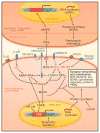Molecular mechanisms of fear learning and memory
- PMID: 22036561
- PMCID: PMC3215943
- DOI: 10.1016/j.cell.2011.10.009
Molecular mechanisms of fear learning and memory
Erratum in
- Cell. 2011 Nov 11;147(4):948
Abstract
Pavlovian fear conditioning is a particularly useful behavioral paradigm for exploring the molecular mechanisms of learning and memory because a well-defined response to a specific environmental stimulus is produced through associative learning processes. Synaptic plasticity in the lateral nucleus of the amygdala (LA) underlies this form of associative learning. Here, we summarize the molecular mechanisms that contribute to this synaptic plasticity in the context of auditory fear conditioning, the form of fear conditioning best understood at the molecular level. We discuss the neurotransmitter systems and signaling cascades that contribute to three phases of auditory fear conditioning: acquisition, consolidation, and reconsolidation. These studies suggest that multiple intracellular signaling pathways, including those triggered by activation of Hebbian processes and neuromodulatory receptors, interact to produce neural plasticity in the LA and behavioral fear conditioning. Collectively, this body of research illustrates the power of fear conditioning as a model system for characterizing the mechanisms of learning and memory in mammals and potentially for understanding fear-related disorders, such as PTSD and phobias.
Copyright © 2011 Elsevier Inc. All rights reserved.
Figures




References
-
- Abel T, Nguyen PV, Barad M, Deuel TA, Kandel ER, Bourtchouladze R. Genetic demonstration of a role for PKA in the late phase of LTP and in hippocampus-based long-term memory. Cell. 1997;88:615–626. - PubMed
-
- Adams JP, Sweatt JD. Molecular psychology: roles for the ERK MAP kinase cascade in memory. Annu Rev Pharmacol Toxicol. 2002;42:135–163. - PubMed
Publication types
MeSH terms
Grants and funding
LinkOut - more resources
Full Text Sources
Other Literature Sources
Medical

